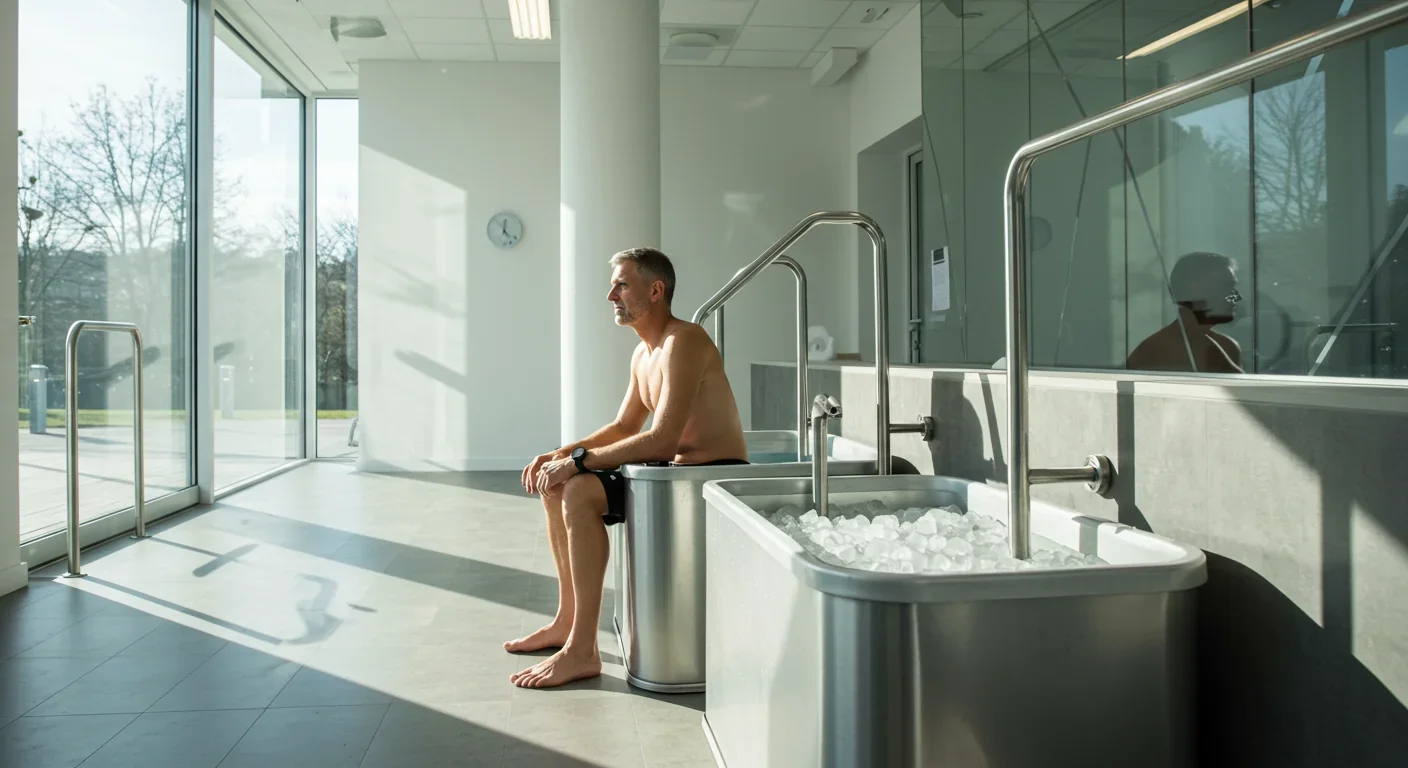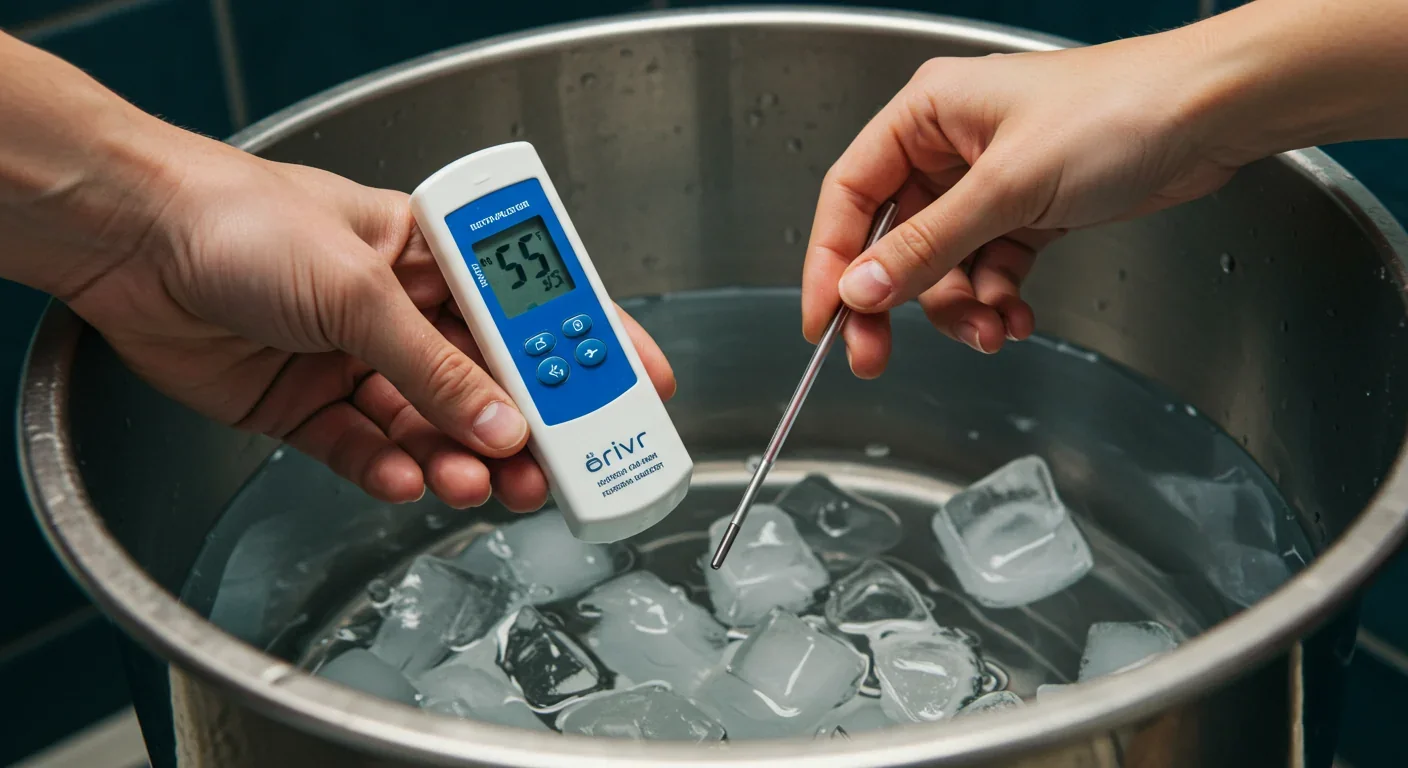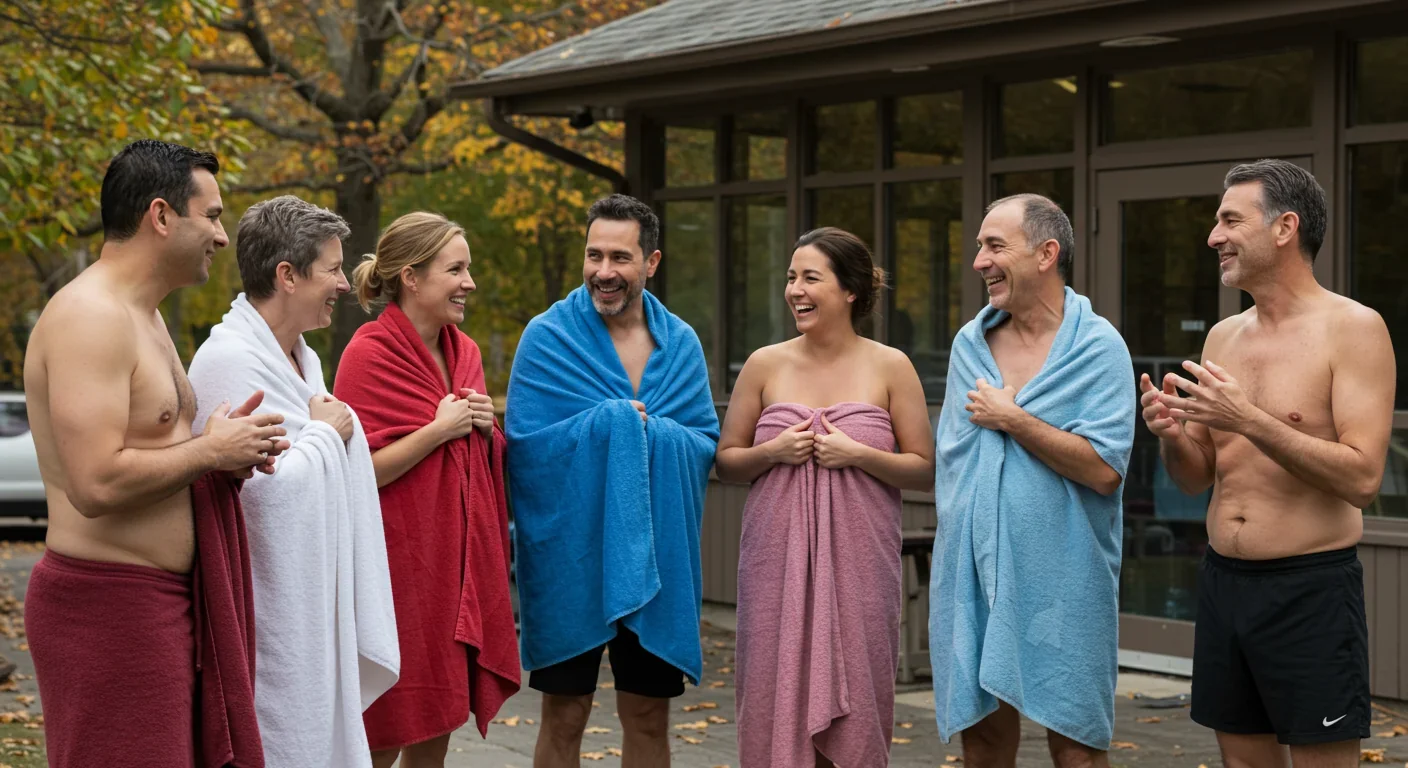Epigenetic Clocks Predict Disease 30 Years Early

TL;DR: Cold exposure activates brown fat, triggers mitochondrial renewal, and may reduce inflammation. While promising, long-term evidence linking ice baths to extended lifespan remains limited.

In 2030, longevity clinics worldwide could prescribe cold exposure as routinely as they recommend exercise. What was once the domain of elite athletes and extreme biohackers is rapidly becoming mainstream medicine, and the science is starting to catch up with the hype. Researchers have identified multiple pathways through which controlled cold stress might extend not just healthspan, but lifespan itself—triggering ancient survival mechanisms that evolved to help our ancestors survive harsh winters. The question is no longer if cold exposure affects longevity markers, but how much and for whom.
Here's what happens when you plunge into ice water: your body doesn't just shiver. Within seconds, brown adipose tissue activates, a specialized fat that burns energy to generate heat. Unlike the white fat most of us want to lose, brown fat is packed with mitochondria—the cellular powerhouses that determine how efficiently we age. When cold activates a protein called UCP1 (uncoupling protein 1), these mitochondria shift from producing chemical energy to generating pure heat. It's a metabolic trick that infants use to survive, and recent discoveries show adults retain the precursors to make more of this beneficial tissue.
The implications are staggering. Cold exposure doesn't merely activate existing brown fat—it appears to trigger the creation of new mitochondria through a process called mitochondrial biogenesis. This cellular renovation could be the key to maintaining energy production as we age, since mitochondrial dysfunction is one of the hallmarks of aging itself.
But the mitochondrial story is just the beginning. Research suggests that controlled cold exposure creates what physiologists call "hormetic stress"—brief, beneficial stress that strengthens the body's stress-response system rather than depleting it. Regular cold plunges can regulate cortisol patterns and reduce inflammatory markers, two factors that accelerate aging when chronically elevated.
Humans have used cold water for health since ancient Greece, when Hippocrates prescribed it for everything from fatigue to fever. The Spartans bathed in the icy Eurotas River. Nordic cultures have practiced winter swimming for centuries. What's changed is our understanding of why it works.
The breakthrough came in the early 2000s, when scientists discovered that adult humans possess functional brown adipose tissue—something previously thought to disappear after infancy. This overturned decades of assumptions and opened new research into cold's metabolic effects. By 2009, imaging studies confirmed that cold exposure activates brown fat in adults, and the race was on to understand its implications for obesity, diabetes, and aging.
Then came the work on autophagy—the cellular "recycling" process that clears out damaged proteins and organelles. In 2016, Yoshinori Ohsumi won the Nobel Prize for mapping how cells break down and repurpose their components. Cold stress appears to trigger this same cleanup mechanism, though the exact pathways are still being mapped. Research indicates that cold exposure stimulates cellular repair mechanisms that could slow the accumulation of cellular "junk" that drives aging.
What's remarkable is how these ancient practices align with cutting-edge biology. The Wim Hof Method, combining cold exposure with breathing techniques, has been subjected to controlled trials showing measurable effects on immune response and inflammation. Scandinavian countries, with their tradition of ice swimming, consistently rank among the world's healthiest populations—though whether cold water deserves credit remains an open question.
Here's where it gets complicated. Studies link ice baths to improved heart health, faster recovery, and stronger emotional wellbeing. Alternating between cold and warm environments—contrast therapy—improves blood flow and cardiovascular function. The cold triggers vasoconstriction (blood vessels tighten), followed by vasodilation (they expand) when you warm up. This vascular "workout" might strengthen blood vessel walls and improve circulation over time.
But there's a catch. The same cold shock that benefits healthy hearts can be dangerous for those with cardiovascular disease. When you hit cold water, your blood pressure spikes, your heart rate jumps, and you hyperventilate—exactly what you don't want if you have a heart condition. Medical experts warn that people with cardiovascular issues should consult a doctor before trying cold water therapy.
This paradox reveals a crucial principle: cold exposure is hormetic stress. Like exercise, it strengthens you through controlled damage—but only if your system can handle and adapt to that damage. For someone with a healthy cardiovascular system, the stress-adaptation cycle might extend longevity. For someone with compromised circulation, it could trigger a cardiac event.
The evidence for cardiovascular benefits is encouraging but preliminary. Most studies measure short-term markers like blood pressure, heart rate variability, and inflammatory cytokines. What we lack are large, long-term trials showing whether regular cold exposure actually reduces cardiovascular mortality over decades. The mechanism is plausible; the data is suggestive; the proof is still being gathered.
Chronic inflammation is aging's silent accelerator. It drives everything from arthritis to Alzheimer's, cancer to cardiovascular disease. If cold exposure genuinely reduces systemic inflammation, it could affect multiple age-related diseases at once.
The evidence here is more solid. Cold immersion reduces muscle soreness and inflammation, which is why athletes have used ice baths for decades. But athletes care about next week's performance, not longevity. The question is whether short-term anti-inflammatory effects translate to long-term health benefits.
Recent research suggests that regular cold exposure may boost immune response by increasing white blood cell count and stress resilience. This makes biological sense: mild stressors train the immune system, just as vaccines do. The controlled stress of cold water might keep immune surveillance sharp, helping the body identify and eliminate damaged cells before they become cancerous or senescent.
Some researchers are exploring whether cold exposure could directly target cancer cells. Emerging studies suggest that cold might help "starve" cancer cells by altering their metabolism. Cancer cells typically thrive on glucose and struggle in cold, low-nutrient environments. While this research is preliminary and mostly in cell cultures, it points to unexpected therapeutic possibilities.

The inflammation story ties back to brown fat. When brown adipose tissue activates, it doesn't just burn calories—it secretes signaling molecules called batokines that have anti-inflammatory effects throughout the body. Scientists have identified new brown fat pathways that could make weight loss easier to maintain, suggesting that cold-induced brown fat might protect against metabolic disease, a major driver of inflammation.
Physical health is only part of longevity. Mental resilience—the ability to handle stress without psychological damage—might be equally important for a long, healthy life. And here, cold exposure shows surprising promise.
Cold water immersion triggers a massive release of norepinephrine, a neurotransmitter that improves focus, mood, and alertness. Regular cold exposure might recalibrate your stress response, making everyday stressors feel more manageable. This isn't just speculation; controlled studies show that cold exposure can reduce symptoms of depression and anxiety in some people.
The mechanism likely involves controlled activation of the sympathetic nervous system—your "fight or flight" response. By voluntarily triggering this system in a safe context (a cold shower), you train your body to handle activation and recovery. Over time, this could make you more stress-resilient, less prone to chronic cortisol elevation, and better able to maintain the psychological wellbeing that correlates with longevity.
Some research links temperature exposure to mental health outcomes, though the mechanisms remain unclear. Does cold exposure directly affect brain chemistry, or does it work through improved self-efficacy and ritual? When you voluntarily do something hard every morning, you prove to yourself that you can handle discomfort—a mindset that might extend to other life challenges.
There's also the sleep connection. Lowering body temperature after cold exposure may help regulate circadian rhythms and promote deeper sleep. Since sleep quality strongly predicts longevity, any intervention that improves sleep deserves attention. The post-cold temperature drop mimics the natural cooling that signals bedtime, potentially strengthening your circadian clock.
So you want to try ice baths for longevity? Start gradually, or you'll just hate it and quit.
Typical cold water therapy involves immersing your body in 10–15°C (50–59°F) water for 3–10 minutes. But if you're new, start warmer and shorter. Try ending your shower with 30 seconds of cold water. Once that feels manageable, increase to a minute, then two.
When you're ready for full immersion, aim for water around 15°C. Most people should limit time to 2–5 minutes; longer exposure isn't always better. The goal is hormetic stress, not hypothermia.
The dosage question is still being answered. Some protocols suggest daily exposure, others recommend 2–3 times per week. Emerging protocols suggest that frequency matters more than duration—brief, regular exposure might be more effective than occasional long sessions.
Breathe slowly and deliberately when you first hit the water. Your body's instinct is to hyperventilate, but controlled breathing helps you adapt. Focus on extending your exhales to activate the parasympathetic nervous system, which calms the stress response.
Safety is critical. Never do cold exposure alone if you're doing full immersion, especially in natural water. Cold shock can cause involuntary gasping, which is dangerous if your face is underwater. Don't consume alcohol before cold immersion—it impairs judgment and temperature regulation.
If you have cardiovascular disease, high blood pressure, or are pregnant, talk to your doctor first. Cold exposure is generally safe for healthy people, but it's a significant physiological stressor.
Here's what we don't know: whether cold exposure actually extends human lifespan. We have plausible mechanisms. We have short-term biomarker improvements. What we lack are decades-long studies tracking mortality in regular cold bathers versus matched controls.
The research on telomeres—the protective caps on chromosomes that shorten with age—is virtually nonexistent for cold exposure. Same for senescent cell clearance, another hallmark of aging. We have hints that autophagy increases with cold stress, but the long-term implications remain unclear.
The dose-response relationship needs much more investigation. Is there an optimal temperature, duration, and frequency? Does individual variation matter more than we think? Should protocols differ by age, sex, or baseline health?
There's also the placebo problem. Cold exposure requires commitment, creates a ritual, and makes people feel like they're taking control of their health. How much of the benefit comes from the physiological stress, and how much from psychological factors? This matters less for individual users (a benefit is a benefit) but more for understanding mechanisms.
Recent research from bioRxiv is beginning to map some of these pathways at the molecular level, but we need far more studies before we can make definitive claims about cold exposure and lifespan extension.

While scientists debate mechanisms, popular adoption is exploding. Athletes, influencers, home equipment manufacturers, and biohacking communities have created a cultural shift toward accessible resilience practices. You can buy a cold plunge tub for your backyard. Apps track your cold exposure streaks. Social media is full of people documenting their ice bath journeys.
This democratization has pros and cons. On one hand, it makes a potentially valuable health practice available to millions. On the other, it creates hype that outpaces evidence, leading some people to expect miracle results or ignore safety considerations.
The commercialization also raises equity questions. High-end cryotherapy chambers cost thousands of dollars. Whole-body cryotherapy sessions can run $50–100 per session. Meanwhile, a cold shower costs nothing. The science doesn't clearly favor expensive equipment over simple cold water, but marketing might convince you otherwise.
Different cultures approach cold exposure differently. In Finland, ice swimming is a communal winter tradition. In Japan, misogi—Shinto purification rituals involving cold water—has been practiced for centuries. In Russia, the "walrus clubs" of winter swimmers have medical supervision and careful protocols. What works in one cultural context might not transfer directly to another.
If you're healthy and curious, there's little downside to trying cold exposure. Start with cold showers. If you enjoy it and feel good afterward, consider progressing to cold baths or natural water swimming.
Pay attention to how you feel, not just immediately after but hours later. Some people feel energized; others feel depleted. Cold exposure might not be universally beneficial—individual response varies.
Don't expect ice baths to replace exercise, nutrition, sleep, or stress management. View cold exposure as one tool among many for health optimization. The people who live longest typically do many things right, not one magic intervention.
Track your progress if you want, but don't obsess over it. The psychological benefits of cold exposure might depend partly on the challenge and accomplishment, not just the physiological stress. If it becomes another source of anxiety, you've missed the point.
Most importantly, remember that longevity science is probabilistic, not deterministic. Cold exposure might improve your odds of a longer, healthier life, but it's no guarantee. Genetics, environment, and pure chance still matter enormously.
Can ice baths extend your lifespan? Probably not by themselves. Can they be part of a lifestyle that promotes longevity? Almost certainly. The evidence suggests that regular cold exposure improves multiple biomarkers associated with aging—inflammation, metabolic health, stress resilience, and possibly mitochondrial function.
But we're still in the early stages of understanding. The next decade will bring better data, clearer protocols, and more nuanced understanding of who benefits most and how. Until then, cold exposure remains a promising but unproven longevity intervention.
What we can say with confidence is that cold exposure is a powerful physiological stressor that triggers ancient adaptive pathways. Whether those adaptations translate to extra years of life, we'll know in a few decades when today's ice bathers reach old age. In the meantime, if you enjoy the practice and feel better doing it, that might be reason enough to continue.
The frozen fountain of youth might not be a fountain at all, but rather a pool you have to willingly jump into—repeatedly, uncomfortably, and with no guaranteed reward except the knowledge that you're voluntarily doing something hard. In a world of comfort and convenience, that alone might be the most valuable intervention of all.

Recent breakthroughs in fusion technology—including 351,000-gauss magnetic fields, AI-driven plasma diagnostics, and net energy gain at the National Ignition Facility—are transforming fusion propulsion from science fiction to engineering frontier. Scientists now have a realistic pathway to accelerate spacecraft to 10% of light speed, enabling a 43-year journey to Alpha Centauri. While challenges remain in miniaturization, neutron management, and sustained operation, the physics barriers have ...

Epigenetic clocks measure DNA methylation patterns to calculate biological age, which predicts disease risk up to 30 years before symptoms appear. Landmark studies show that accelerated epigenetic aging forecasts cardiovascular disease, diabetes, and neurodegeneration with remarkable accuracy. Lifestyle interventions—Mediterranean diet, structured exercise, quality sleep, stress management—can measurably reverse biological aging, reducing epigenetic age by 1-2 years within months. Commercial ...

Data centers consumed 415 terawatt-hours of electricity in 2024 and will nearly double that by 2030, driven by AI's insatiable energy appetite. Despite tech giants' renewable pledges, actual emissions are up to 662% higher than reported due to accounting loopholes. A digital pollution tax—similar to Europe's carbon border tariff—could finally force the industry to invest in efficiency technologies like liquid cooling, waste heat recovery, and time-matched renewable power, transforming volunta...

Humans are hardwired to see invisible agents—gods, ghosts, conspiracies—thanks to the Hyperactive Agency Detection Device (HADD), an evolutionary survival mechanism that favored false alarms over fatal misses. This cognitive bias, rooted in brain regions like the temporoparietal junction and medial prefrontal cortex, generates religious beliefs, animistic worldviews, and conspiracy theories across all cultures. Understanding HADD doesn't eliminate belief, but it helps us recognize when our pa...

The bombardier beetle has perfected a chemical defense system that human engineers are still trying to replicate: a two-chamber micro-combustion engine that mixes hydroquinone and hydrogen peroxide to create explosive 100°C sprays at up to 500 pulses per second, aimed with 270-degree precision. This tiny insect's biochemical marvel is inspiring revolutionary technologies in aerospace propulsion, pharmaceutical delivery, and fire suppression. By 2030, beetle-inspired systems could position sat...

The U.S. faces a catastrophic care worker shortage driven by poverty-level wages, overwhelming burnout, and systemic undervaluation. With 99% of nursing homes hiring and 9.7 million openings projected by 2034, the crisis threatens patient safety, family stability, and economic productivity. Evidence-based solutions—wage reforms, streamlined training, technology integration, and policy enforcement—exist and work, but require sustained political will and cultural recognition that caregiving is ...

Every major AI model was trained on copyrighted text scraped without permission, triggering billion-dollar lawsuits and forcing a reckoning between innovation and creator rights. The future depends on finding balance between transformative AI development and fair compensation for the people whose work fuels it.